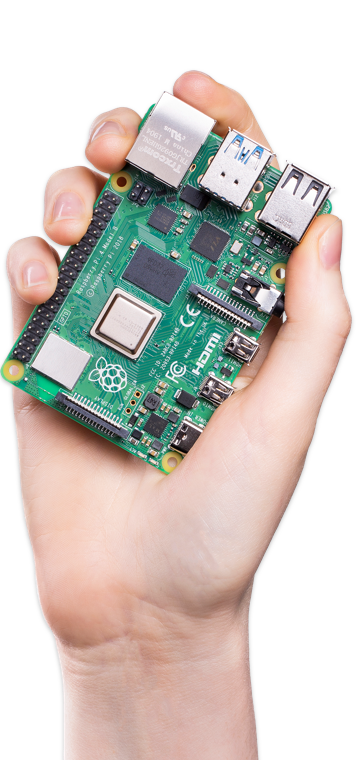The Raspberry Pi
The Raspberry Pi is a highly popular, low-cost single-board computer (SBC). Built on open-source principles and developed with the non-profit incentive to increase global access to computing and digital making, it brings together external hardware, sensor, and controller interfaces, with user-friendly programming capabilities, high connectivity, and desktop functionality.
 The Raspberry Pi is a low-cost, single-board computer (SBC) developed by the Raspberry Pi Foundation (raspberrypi.org), a UK-based charity. Since its first release in 2012, several generations of Raspberry Pi micro-computers have been released, which can be categorised in three distinct models: the Raspberry Pi A, B, and Zero (a fourth model, the Compute Module, is mainly used in industrial applications). The fundamentals of these three models (henceforth “Raspberry Pi’s”) are highly similar (see also Box 2), with each featuring a system-on-a-chip that consists of an integrated CPU (Central Processing Unit) and GPU (on-chip graphics processing unit), on-board memory, and a power input of 5V DC.
The Raspberry Pi is a low-cost, single-board computer (SBC) developed by the Raspberry Pi Foundation (raspberrypi.org), a UK-based charity. Since its first release in 2012, several generations of Raspberry Pi micro-computers have been released, which can be categorised in three distinct models: the Raspberry Pi A, B, and Zero (a fourth model, the Compute Module, is mainly used in industrial applications). The fundamentals of these three models (henceforth “Raspberry Pi’s”) are highly similar (see also Box 2), with each featuring a system-on-a-chip that consists of an integrated CPU (Central Processing Unit) and GPU (on-chip graphics processing unit), on-board memory, and a power input of 5V DC.
All models also have a port to connect a dedicated camera as well as an array of general-purpose input/output (GPIO) pins, which can be used to communicate with a wide range of electronics, from LEDs and buttons, to servos and motors, power relays, and a huge range of sensors.
Special expansion boards that connect to the GPIO pins, called HATS (Hardware Attached on Top), can provide further functionality, ranging from power management, RFID detection, motor controllers, and high-quality audio recording. Most models also feature an Ethernet connection and wireless (Wi-Fi and Bluetooth) connectivity, which, in combination with the GPIO ports, give the Raspberry Pi a huge versatility.
The Raspberry Pi has all the functionalities of a standard computer. As such, you can connect a mouse, keyboard, and computer screen without any configuration and have control over an easy-to-use Linux Desktop environment. Besides Raspberry Pi OS, which is maintained by the Raspberry Pi foundation, many other operating systems can be installed, including Windows 10 IoT and Android. The Raspberry Pi can also be used as a headless, remotely controlled unit, and programmed to run scripts autonomously using a wide-range of computer languages.
The Raspberry Pi is different from a microcontroller, such as the popular Arduino or the recently released Raspberry Pi Pico, which are much more basic computers with very low energy requirements that simply execute a single user-written program.
The Raspberry Pi a great research tool that can be used for almost anything, from simple environmental monitoring and recording of laboratory experiments, to autonomous field measurement stations, and advanced closed-loop devices that can read various input modules, trigger other actions (e.g. to turn lights or servos on and off), and automatically process data and send warning messages.
Advantages of the Raspberry Pi
- Large processing power in a very compact board
- Large number of dedicated interfaces (UART, I2C, SPI, I2S, CSI, DSI) to connect a wide range of sensors and electrical components
- High connectivity (HDMI, USB, Ethernet, Wi-Fi, Bluetooth)
- Low price, ranging from as little as €5 (RPi Zero; €60 for the RPi 4B, 8GB)
- Very high ease of use with huge user community, extensive resources, and easy to understand tutorials (see raspberrypi.org)
- Works both headless and as a full desktop computer
- No extensive programming experience required and small learning curve
- Easy to deploy and highly portable due to its small size
- Long-term automated image and video recording with high customization
- Built-in HDMI capable graphics (up to 4K)
- Low power consumption (but higher than microcontrollers) and can be powered by wide range of external batteries and solar panels
- Contains no moving parts and is silent
- High customisability and flexibility as compared to commercial solutions
- High transferability and backwards compatibility
Disadvantages of the Raspberry Pi
- Comes as a bare circuit board, but many compact cases are available
- Not as powerful as a traditional PC
- Some command-line programming and knowledge of electronics may be beneficial (but can be learned very quickly)
- More advanced applications will require decent programming knowledge and electronic skills, which is not needed for most commercial solutions
- No built-in analog-to-digital conversion (can be easily added)
- No power button or sleep mode (possible with power management HATS)
- Custom setups may complicate standardisation and replicability (but can be overcome by detailed standardised (online) documentation)